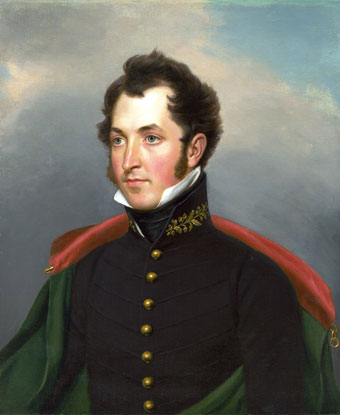Last updated: August 6, 2019
Person
Samuel Ringgold

National Portrait Gallery, Smithsonian Institution; gift of the William Woodville Estate
Early Life
Samuel Ringgold was born near Hagerstown, MD in the year 1800. Ringgold was the eldest son of Brigadier General, Samuel Ringgold, a veteran of the War of 1812.
The younger Ringgold entered the United States Military Academy at West Point in 1814 and graduated near the top of his class in 1818. By 1822 he had risen to the rank of 1st Lieutenant and then earned the brevet of Captain in 1832. In 1836, Captain Samuel Ringgold took command of the 3rd Field Artillery Regiment and served in the campaigns in Florida. While serving in Florida, Ringgold’s health became weakened.
Ringgold went off to Europe in an effort to better his health and to study at the École Polytechnique in Paris and Sandhurst Royal Military College in London. It was there where learned the advantages of a light artillery system and its possible contributions in combat.
Return from Europe
Ringgold returned to the U.S. in 1838. However, upon his arrival, he learned his artillery company war ordered to disband. Consequently, Secretary of War Poinsett ordered Captain Ringgold to organize a company of light artillery. This was somewhat of an unusual request. At the time, light artillery was a novel component of the service. Nevertheless, in 1838, Secretary of War Poinsett ordered four light artillery companies to be mounted. Under Ringgold’s direction, each regiment of heavy artillery would have one company equipped with lighter cannons and horses.
Flying Artillery
The first company mounted as a horse battery was Company C, 3d Regiment of Artillery commanded by Samuel Ringgold. The company received new field guns and horses. Ringgold’s cannoneers were mounted on horseback making his company true flying artillery. The companies that followed were equipped as mounted batteries. Cannoneers in these companies tended to ride on the carriages or caissons or even walked next to their guns.
“He established himself at Carlisle, PA, where, by constant practice, he brought both horses and men to such a state of perfection, that, when drilling they seemed to move by volition alone… with such rapidity that the eye could scarcely follow their movement…”1 While at Carlisle, Ringgold received the brevet of Major, for his services in the Florida war;
U.S.-Mexican War
Ringgold’s brainchild would take center stage in the opening battle of the U.S.-Mexican War on May 8, 1846, on the prairie of Palo Alto. When General Zachary Taylor’s force arrived on scene, they found General Arista’s army already deployed in battle formation. In addition, they found themselves outnumbered by their opposing Mexican force by about 1,000 troops, making a frontal assault impossible. General Taylor decided to deploy his flying artillery instead. An artillery duel would decide the Battle of Palo Alto.
The execution by the U.S. flying artillery not only made up for the manpower deficit but exacted a heavy toll on the Mexican battle line. Working in conjunction with a pair of heavy U.S. 18-pounder siege cannon, they wreaked havoc on Arista’s troops.
The Mexican artillery was generally ineffective but it did manage to strike a devastating blow to Taylor’s army. A Mexican artillery round mortally wounded Ringgold while he was commanding his guns. Even at this moment, Ringgold put his men before himself. When they came to his assistance, he waved them off and reminded them of the work they still needed to do. Ringgold would succumb to his wounds on May 11th.
Legacy
The work Ringgold put into the U.S. flying artillery would serve the U.S. Army well throughout the rest of the Mexican War. The U.S. flying artillery saw action many times in the ensuing battles of the war and carried itself well. Ringgold’s tireless efforts to better the U.S. light artillery had a profound effect on the performance of the U.S. Army during the war and the success it enjoyed during the conflict.
1. Peterson, J. Charles. The Military Heroes of the War of 1812. Philadelphia: James B. Smith & CO., 1852.
